Echoes of War: The Franz Family’s Tragic Legacy.
With seven children born to my maternal great grandparents between 1886 and 1901, you would expect many descendants today. However, my maternal grandfather, William Theodore Franz, was the only one who married and had children. His sister Edith died at seven years of age after being thrown from a horse. Sisters Dora and Lillian lived long lives but never married or had children. The youngest brother, Clem, was killed at 32 years old by a falling log. The most tragic fates were those of his other two brothers, Cecil and Arthur.
Both were victims of World War One, albeit in different ways. Cecil died from war injuries sustained in 1918 in France. Although also injured, Arthur returned from The Great war. Yet, his mysterious disappearance in 1930, can also be attributed to the effects of that horrendous war.
I first heard the story of Arthur’s disappearance from my mother. We were watching an old movie on television, and she wondered if the actor Arthur Franz was her uncle, who went missing in 1930. She said she had always liked to think he had run away to America to become a film star, although she knew it was unlikely. The actor, Arthur Franz, was born in 1920.[1] Mum told me the story.
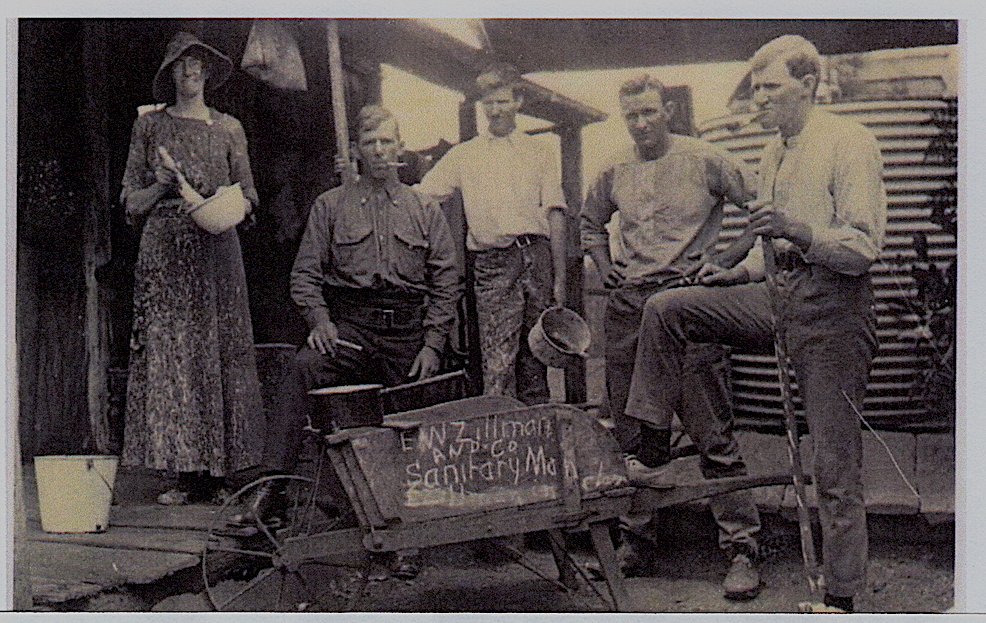
L to R. Annie (Ellie)Zillman, her brothers Arthur and Rudolph (Redvers), their Uncles Charles Haddon (Charlie) and Eric Wesley (Ben) Zillman. Authors private collection.
Arthur Edward Franz was born in Brisbane on 19th January 1892. His father, William Frederick Franz, was the son of a missionary brought to Australia by John Dunmore Lang to establish a mission for the aboriginal people at what is now Nundah in Brisbane. The mission was abandoned around 1850 and the Franz family purchased land at Stoney Creek, now Burpengary Creek, near Moorina, Upper Caboolture about 68 km north of Brisbane. Along with another missionary family, the Zillmans, they were among the first European settlers there. Arthur’s mother, Margaret Jane Bleakley also came from a family of early settlers there. Her parents arrived in Australia from Ireland in 1860 and her father was warden of Johann Zillman’s farm, until he could purchase his own property.
Arthur grew up on his family’s farm. He attended Rocksberg school and worked on the family farm and as a teamster.[2] He had friends amongst the children from nearby farms.
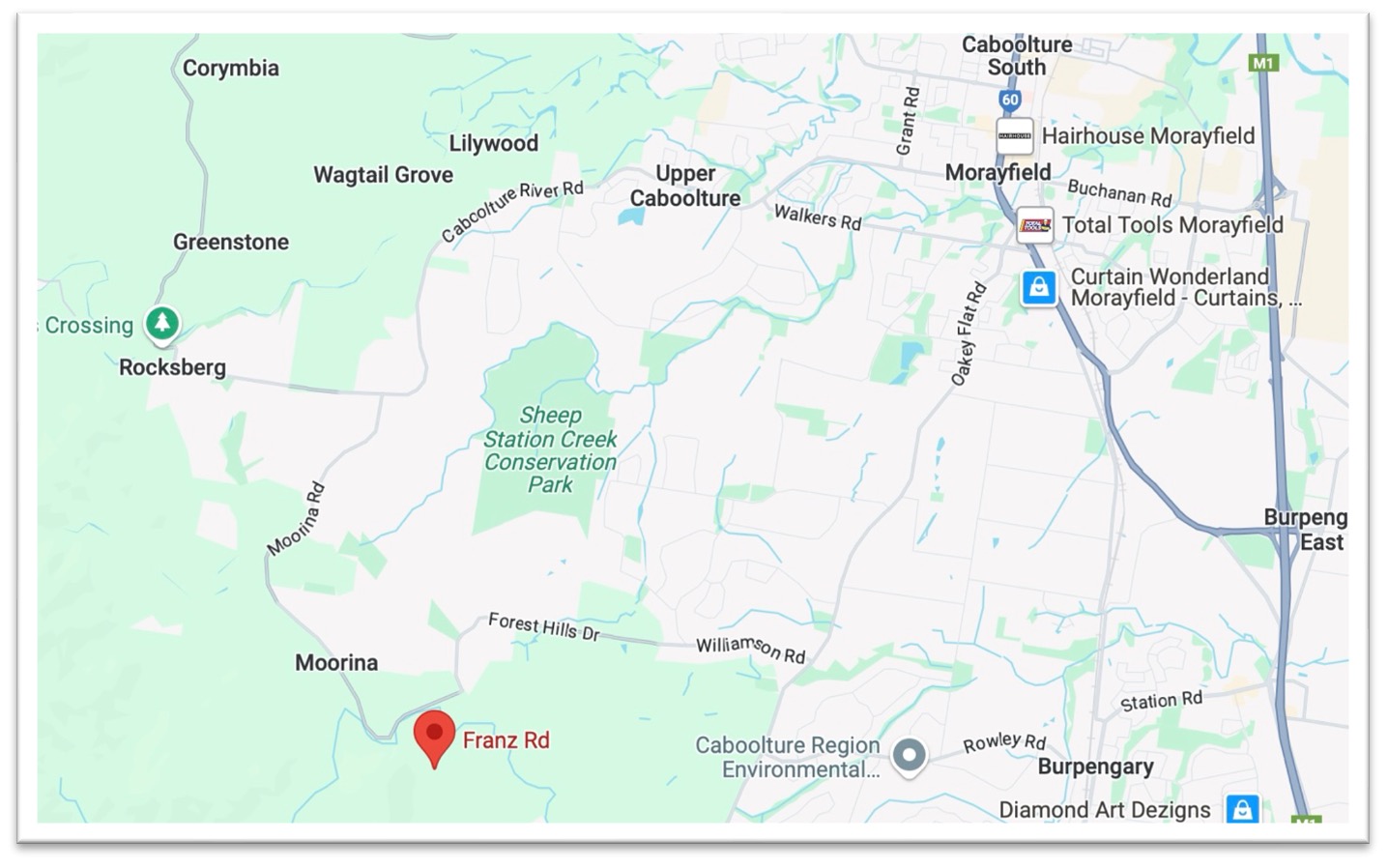
IMAGE ONE: Franz Family Farm at Moorina, Queensland Google maps, accessed 24 February 2025.
Unlike many others, Arthur did not enlist immediately in World War One. However, by late in 1915, with enlistment waning, recruitment efforts intensified with extensive press advertising, billboards, and marches like the March of the Dungarees, where a group of enlistees left Warwick in November 1915 and marched to Brisbane gathering other recruits along the way.[3]
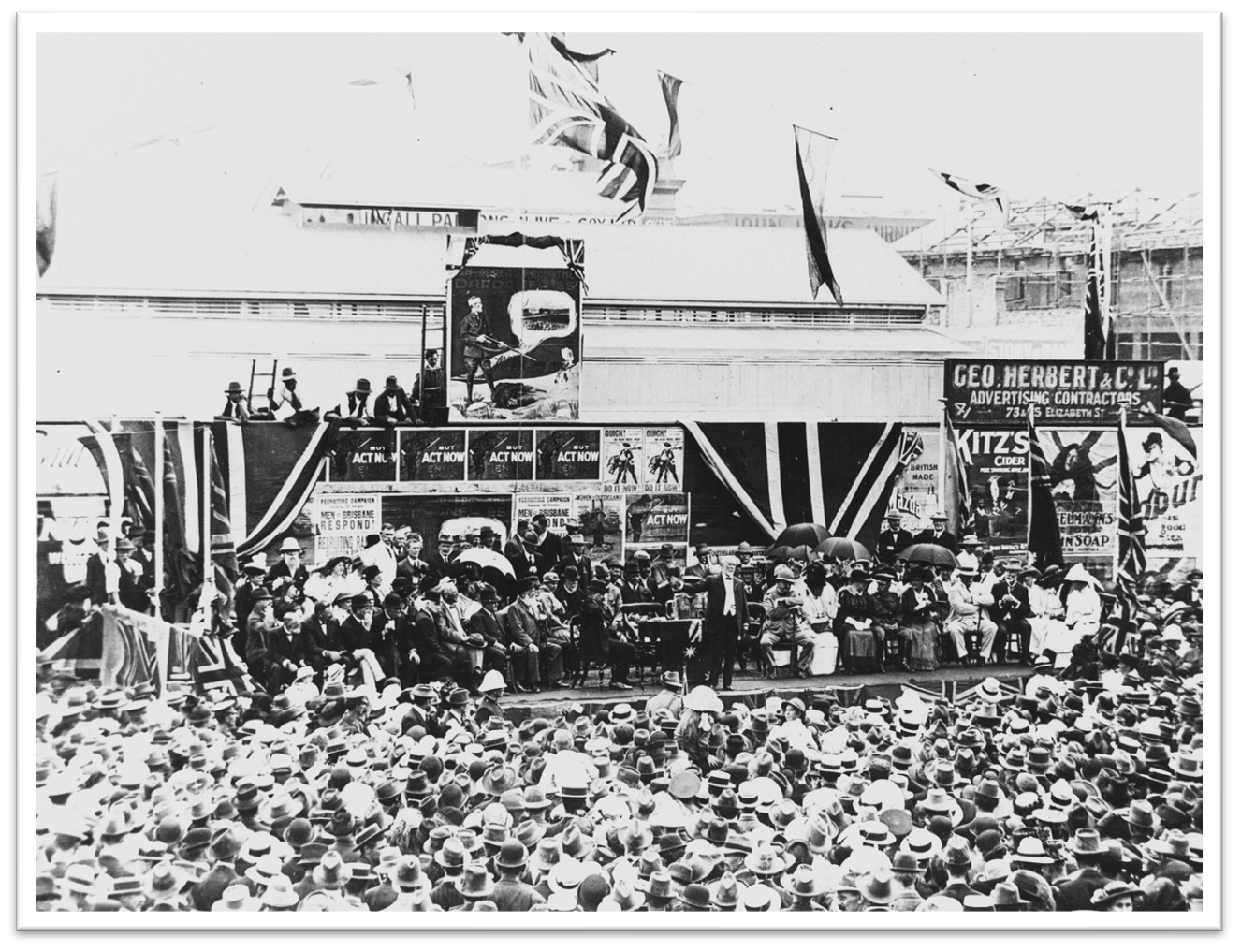
Dungarees Recruiting Campaign, November 1915. Unknown author, Precise location unknown.
Despite being second generation Australian born, Arthur’s German name might have caused some bullying. In this atmosphere, Arthur enlisted in February 1916. His older brother, my grandfather, was busy establishing his own farm with a pregnant wife and two children. Cecil, who initially promised to stay and help his ailing father on the farm enlisted later that year after receiving a ‘white feather’ (a sign of cowardice) reportedly from the mother of a girl he was seeing. The youngest brother, Clem was only 15 years old.
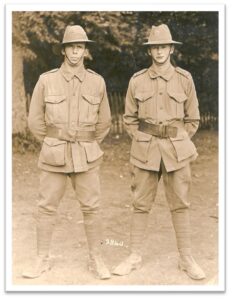
Arthur and Cecil Franz, about 1917, probably in France. From authors private collection.
Arthur was assigned as a driver to the 11th Machine Gun Company and embarked overseas in June 1916. He was hospitalised twice during the passage, once with influenza. By November 1916 he was in France. Cecil embarked for overseas in February 1917. In September 1917, he wrote to his sister Lilian that he often saw Arthur while they were in France. They had a picture taken together in their uniforms.
Unfortunately, in April 1918 Cecil was severely wounded in both legs and the spine in the vicinity of Rouelles in France and passed away in May 1918. He is buried in the Brookwood Military Cemetery.[4]
Arthur managed to keep well until August 1918 when he was wounded and hospitalised. His wound was reported to be deep with a substantial loss of blood and in April 1919 he began the journey to get home, finally returning in May 1919.[5]
At home, and with the war ended, Arthur resumed his life. He had his own farm near the main family farm where he lived with his mother, younger brother and sister. He slept in a room downstairs. However, the war and the loss of his brother must have taken a toll. Later it was reported that he suffered bouts of depression that was attributed to war injuries rather than his domestic and financial position.[6]
On 6th April 1930, Arthur was discovered to be missing. The account by Arthur’s mother, published in 1941, eleven years later when she applied for probate, reveal the events as they occurred. She recounted that Arthur was discovered missing about 11 am when his brother Clem noticed that his cows had not been milked, and he could not be found. She said she hadn’t seen him since the night before when they had all had dinner as usual and that then Arthur had apparently gone to bed in good spirits.
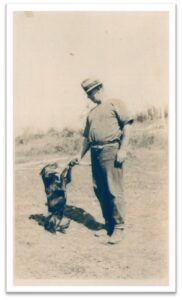
Arthur and his dog; probably late 1920’s at Upper Caboolture. From authors private collection.
She added that his bed had been slept in, and he had left in his working clothes but without a hat or coat. She also noticed that his razor, rifle and some ready cash were in the room and all the firearms in the house were intact.
The family searched till dark. The next day about 40 neighbours led by police, joined the search and a few days later, even more people. They continued for a fortnight and at odd times after, but he was not found. Policemen and a black tracker could find no footprints. Apparently Arthur’s dog would not leave his bedroom. In his affidavit, my grandfather said that undergrowth and Lantana were so thick that one might search within a few feet of a body without seeing it.
Police circulars notifying the disappearance were distributed in Queensland, other States and New Zealand. They bought no response. Rumours circulated, but no evidence was found. In 1942, a newspaper described his disappearance as one of the strangest cases in Queensland. Theories ranged from murder to fantastic claims of disappearing in a space pocket.[7]
We’ll probably never know what happened to my great uncle Arthur, unless his bones are discovered, but I believe that Arthur was a victim of the Great War, like his brother and so many other Queensland young men.
[1] Wikipedia Contributors, ‘Arthur Franz’, Wikipedia, The Free Encyclopaedia, (accessed 23 February 2025)
[2] Ancestry.com.au, Australian Electoral Rolls, 1901-1936 for Arthur Edward Franz in 1913. [on-line database], Provo, UT, USA: Ancestry.com Operations Inc., 2007. Original data – Australian Electoral Commission [Electoral roll] Microfilm mc N 451- mc N457; National Library of Australia, Canberra.
[3] Wikipedia contributors, “Military recruitment in Queensland in World War 1” [on-line website]. Wikipedia, The Free Encyclopedia, accessed 23 February 2025).
[4]Australian Anzacs in the Great War 1914-1918, [on-line database]The AIF Project Details for Cecil Charles Franz.
[5] Australian Anzacs in the Great War 1914-1918, [on-line database] The AIF Project Details for Arthur Edward Franz.
[6] 1941 Man Vanished Without Sign: [on-line website] Courier-Mail, Tuesday 8 July 1941, page 5 Report of events of disappearance with comments of parts of affidavits presented.
[7] Mystery Echo, Farmer Left $2600 Estate, [on-line website] Cairns Post, Tuesday 11 August 1942, page 2; (accessed 21 February 2025)

Comments
Echoes of War: The Franz Family’s Tragic Legacy. — No Comments
HTML tags allowed in your comment: <a href="" title=""> <abbr title=""> <acronym title=""> <b> <blockquote cite=""> <cite> <code> <del datetime=""> <em> <i> <q cite=""> <s> <strike> <strong>